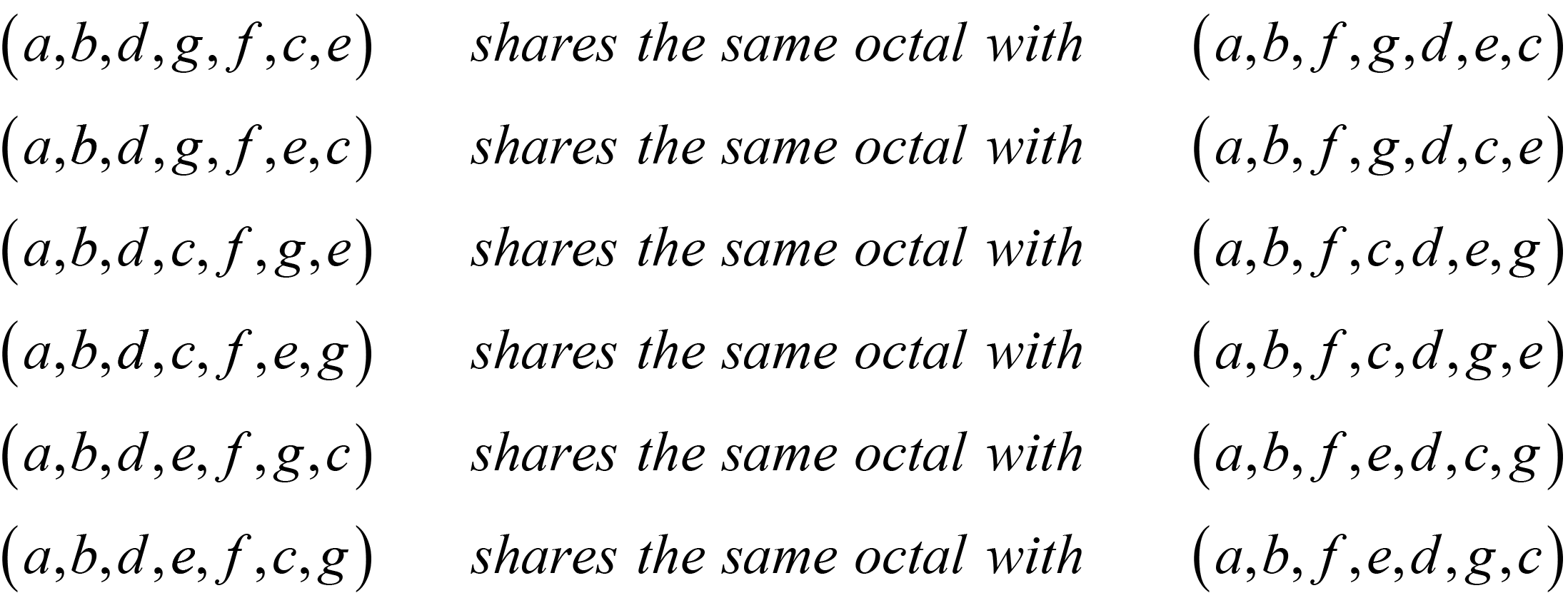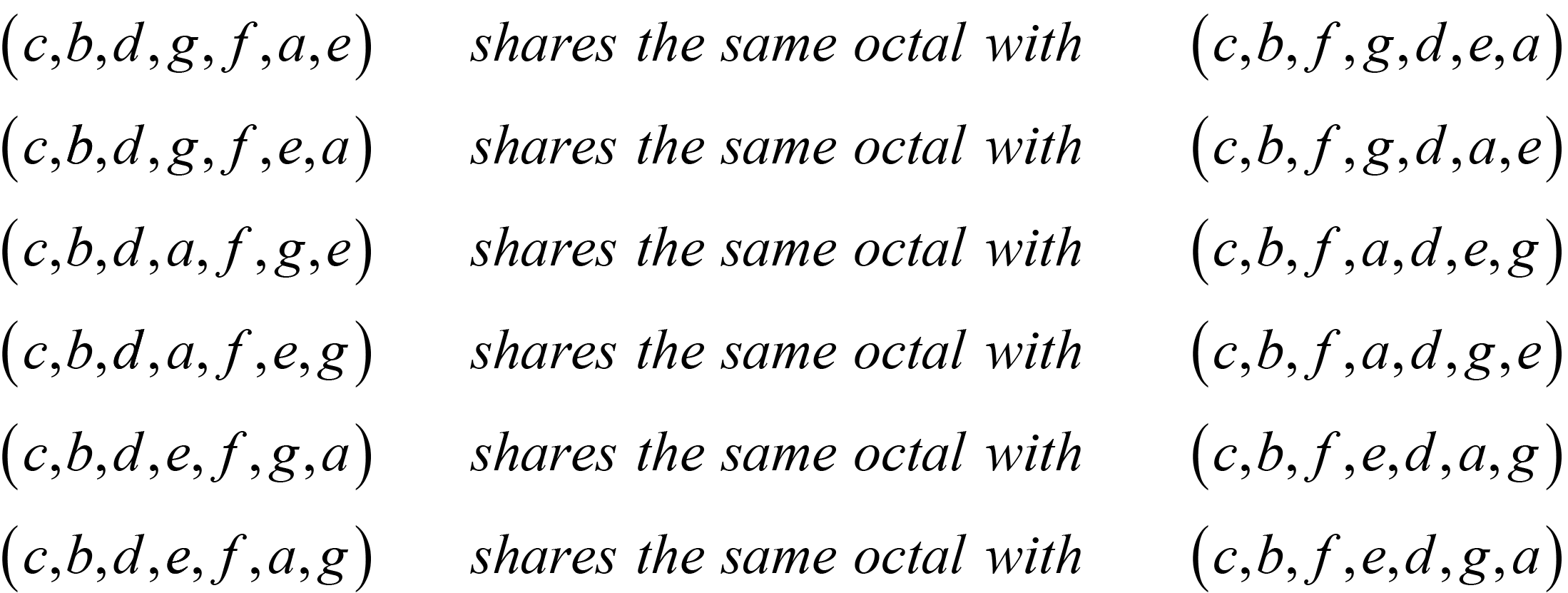Mathematics
|
 The Heart Of The Woman
Given a starting reference octal, say the familiar [a,b,c],[a,d,e],[a,f,g],[b,d,f],[b,e,g],[c,e,f],[c,d,g] used throughout the book, I will pick one coset of a generalised static subgroup, say the coset {a,c,e,g} of [b,d,f] (without any loss of generality).
Those four elements {a,c,e,g} may be permuted in 24 ways holding the elements of [b,d,f] fixed. (With four choices for the unity under the seven cycle.) With a single choice of unity I have twelve seven cycles holding both subgroup and corresponding triple static. These seven cycles are not disjoint over octals, but share octals in pairs.

So, given any "thesis" corresponding to one choice of unity there are six octals with that static subgroup and choice of unity. With a second thesis, an "antithesis" which must be formed of one of the other three choices for unity I have another six octals also.

Now, I can confidently state that seven cycles are valid on only two octals, so If I fix my reference octal I immediately limit myself to one row of each set (each subgroup as [b,d,f] is in six octals as here; but then one row from both sets corresponds to the same octal.)
So, two octals are the same - one from each of those two sets of six, as here, say.

Now, as each seven cycle is valid over only two octals, and these four cycles already share one octal, none of their "left hands" must be equal octals. So, I reduce over the two sets of six octals to just one set of six octals: each of the six disjoint with each of the others in their "left hand" octals, but arranged together in pairs of six "right hand" octals overall.
Now, one of those six "right hand" octals must be the reference octal, and the remaining five are totally disjoint in "left hands" from that reference, as they are also with each other. I remove that one reference octal and the two left hands that correspond to it, leaving me a set of ten seven cycles that share either one or three subgroups with the reference (of which there are two and three respectively, each with two seven cycles, making the full set of ten without the reference), but not the whole seven.
Then I am merely interested in the ten left hand octals of those ten seven cycles: within which the static triples in the balances are become subgroups. (These octals are all different.) As outcomes they transform away from the reference octal with its left hands, which is all the system requires. A synthesis will become a new thesis.
Now, why do I wish to remove the reference octal and two seven cycles from the whole twelve? I have been working on the number of possible left hand octals that may be constructed to form these static triples, but I am truthfully only interested in examining those inside the set numbered 666 of static triples denying virtue.
Then I must immediately discard the two seven cycles over the reference leaving me with ten remaining.
So, I have, depending on two outcomes (or thesis/antithesis) a total of "ten octals by four theses by three antitheses" making a total set of balances numbering 120. I.e. four choices for unity as a thesis, three further choices for unity remaining for the antithesis and the factor of ten as above. (Or four choices for oil, and three for wine.)
Then working upon, using the set numbering 666, the heart of the woman numbers 120.
Then in the consensus of the collective, the heart of the woman (image) will absorb all of these 120 as if into her manifold restricted to but 60, as in a mere "approach pleasure, avoid pain" paradigm. The manifold is truthfully only the heart of the believer assembled and whilst they are presented only with singular oil and wine and but two outcomes, the number of ways to deny virtue is always a bound of the method of dialogue put to the manifold. Each disjunction of virtue may be denied in 120 ways as above but only one denial of Christ is required to fall from grace, when put to the vote. That the "heart" of the wider (and possible) collective may, can or will absorb all 120 permutations of doctrine in the image system into just 60 of the 120 possible outcomes remaining (as singular outcomes of two syntheses) is not the issue: the bounds on the vote are still set outside the reference octal and within the set numbering 666. (There is a bijection between this set of 120 balances and the ten kings chosen in triples limiting it to those triples not in the reference but in that set of 666. The woman rides the beast, though she is not separate to it. The image is yet another (greater) encroachment upon the gospel, a "third woe".)
The vote is only ever put to divisive doctrine, it is a leavening process - the bible is not supposedly put to the vote, but it is wholly leavened by the image system. The 60 parts absorbed is due in reality to the carnality of the believers' decision process of their own manifold rather than the 120 sets of balances that may project that carnality or the "life" of the false prophet as upon the image in the process of leavening doctrine.
Continue To Next Page
Return To Section Start |